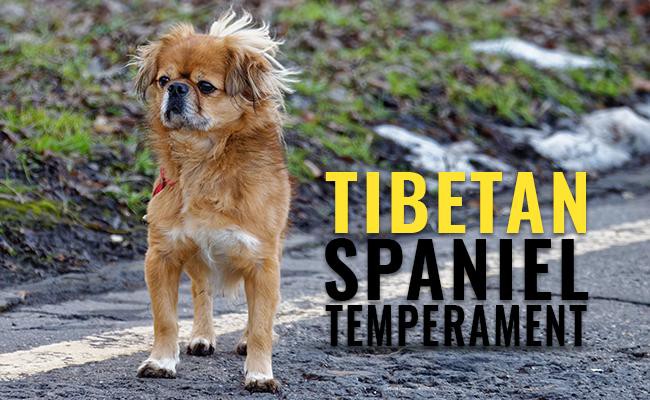Dog Pregnancy Calculator And Timeline
This assertive little intelligent dog, Tibetan Spaniel came into existence long before 2500 years ago. Don’t let their small size make you misjudge their ability to serve as perfect watchdogs.
In fact, they were primarily used as alarm dogs in Buddhist monasteries. They are quite independent and are not always obedient; never let them move around without the leash because they may even pick up fights with other bigger dogs if left free.
Living in a closed community or an apartment can be quite daunting if you own a Tibetan Spaniel; their continuous barking may not be welcome amongst neighbors.
So do consider this important factor prior to bringing this dog breed home, but they can always be trained to behave better. There are so many other unique features of a Tibetan Spaniel that you should know about.
Tibetan Spaniel Breed Characteristics Sheet
- Origin: Tibet
- Size: Short
- Dog Breed Group: Non-Sporting Group
- Purebred: Yes
- Lifespan: 12 -15 Years
- Height (at Shoulder): 9 -10 inches
- Weight: 9 – 15 pounds
- Coat Appearance: Double-layered (soft and silky)
- Coat Colors: Black, White, Black& Tan, Cream, Gold, Dark Sable
- Temperament: Affectionate, Playful, Alert, Stubborn (sometimes)
- Good With Children: Yes (better under elder’s observance)
- Intelligence Level: High
- Good With Pets: High
- Hypoallergenic: No
- Grooming: Moderate to High
- Shedding: Moderate
- Barking: High (Can be controlled with early training)
- Suitable For Apartments: Moderate to High
- Need For Exercise: Low to Moderate
- Easy To Train: No (Need consistent training; can be stubborn at times)
- Good For First Time Owners: Moderate (Will need professional help to train)
- Health Issues: Patellar luxation, Cherry eye, Hernia
- Litter Size: 3-6 puppies
- Average Price: $700 – $900 USD
Tibetan Spaniel Facts
Tibetan Spaniel Size
- Size – Their height ranges between 9 to 10 inches.
- Weight – They are usually a small dog weighing between 9 and 15 pounds.
Tibetan Spaniel Lifespan
The Tibetan Spaniel has a life expectancy of 12 to 15 years. A good, nutritious diet, proper exercise, and routine check-up will help him stay fit longer.
Tibetan Spaniel Mix
Active, alert, great companion dog and a watchdog, Tibetan Spaniel is notable for its intelligence, easy maintenance and care to take care of its owner’s family.
So, people will definitely want to mix the dog having wonderful traits. Tibetan spaniel can be mixed with other adorable breeds such as Poodle, Maltese, etc.
Here’s a list of few such mix breeds.
- Tibetan Spaltese (Maltese +Tibetan Spaniel)
- Tibetan Pug (Pug + Tibetan Spaniel)
- Tibalier (Cavalier King Charles Spaniel + Tibetan Spaniel)
- Tibetan Chin (Japanese Chin + Tibetan Spaniel)
- Tibetanpei Spaniel (Chinese Shar-Pei + Tibetan Spaniel)
- Tiboodle (Poodle + Tibetan Spaniel)
Other than the above mix breeds, Tibetan Spaniel can also be mixed with Chihuahua, Dachshund and Pomeranian breeds!
Tibetan Spaniel Temperament
Tibetan Spaniel was called as “lion dogs” primarily and was considered a symbol of Lord Buddha. They were valued to such an extent that even sometimes they were presented as gifts to royal families and dignitaries.
This breed grew into a lap dog and a common household pet in Tibet and around the world in the early ’80s.
They are the best pets for grown-up children who know how to deal with pets cautiously, younger kids can hurt Tibetan Spaniels with rough play.
They are very intelligent and display keen interest to learn new tricks provided you use a rewarding approach. He may hate being bossed around; so ensure that you avoid punishing him unless it is completely necessary.
They can be used as therapy dogs at old age homes; their genuinely loving ways will obviously help cheer-up lonely hearts.
They get along well with other pets but they may take some time to make friends with strangers. Early socialization can help them get along with new people.
Separation anxiety is a huge problem faced by these pets; so it’s necessary that you train him well to handle times when he is left alone at home.
Tibetan Spaniel Training
Every owner would wish to have his pet obey him and follow every command given, but each dog has unique characteristics. Tibetan Spaniel can be difficult to train if you are a first-time dog owner.
This breed has a stubborn streak that can be handled only with positive reinforcement. For best results, keep the training sessions short and give them treats whenever they obey a command properly.
Crate training should be the primary thing to teach your Spaniel. Once your pet has learned the basics, learning tricks and taking orders would become easy.
Continuous barking can be a problem, especially if you are staying in a closed community.
In order to prevent your dog from barking at every strange person or object he comes across, it would be best to train him and teach him to differentiate between foes and friends.
Tibetan Spaniel usually craves a lot of attention and may suffer from separation anxiety if left alone for a long time.
You need to train your dog to cope up with staying alone; you should help him make use of that time playing with toys and chews or helping you guard the house as a watchdog.
Keeping him engaged will not just distract him but will fill him with a sense of dutifulness in your absence.
Tibetan Spaniel Food
They love eating both dry kibble and raw food, so choosing a particular food brand for this breed wouldn’t be a problem. But since every dog is different, it is important that you test and see what your pet prefers to eat.
Don’t overfeed him; 1 cup of food, split out into 3 to 4 meals would be good. Since they are not much inclined towards heavy exercising, weight gain or obesity can be common problems if fed too much.
Avoid These Foods:
Foods Your Dog Can Eat:
- High-quality brand Dry Kibble
- Turkey
- Lamb
- Vegetables like spinach, lettuce, Broccoli, Sweet Potatoes, and Carrot
- Whole Chicken
- Fish
- Salmon
- Fruits like Oranges, Apples, Bananas
- Brown Rice
Tibetan Spaniel Care
- Keep a close watch on its food habits and feed him only the amount of food that you believe he can digest.
- Get a vet-approved toothpaste for your pet and make sure to brush your pet’s teeth regularly.
- Brushing his teeth daily at the same time of the day will help it get registered in its mind and your pet will wait for you to brush its teeth every day. Try and check out if you don’t believe! Grooming matters a lot.
- Trim its nails at least 2 times a week and ensure they are kept clean.
- The hair on the Tibbie can sometimes grow so long that it may even cover its ears. Check your pet’s ears regularly and clean them if needed to prevent ear infection; remove excessive hair around its ears in order to avoid infestation of bugs, ticks, fleas, and small pests.
- They are quite playful and love playing with small kids. Owing to their small size, the slightest rough play can lead to the pet getting injured badly.
- So whenever you leave a Tibetan Spaniel to play around with your child aged 5 years old, make sure you have someone to watch over both of them.
Tibetan Spaniel Shedding And Grooming
They have a silky soft double coat which is long at the ears, tails, forelegs, and buttocks. They usually shed lightly but it is advisable that you brush its hair 2 to 3 times a week to avoid tangles and matted hair strands.
Give them a bath when you feel they require the most; they are mostly lapdogs and wouldn’t dirty their coats quite fast.
Tibetan Spaniel Health Problems
Tibetan Spaniels are prone to suffer from respiratory, orthopedic, and eye problems. It is not mandatory that the pet will definitely have these health problems but they may face one or the other symptom as it grows old.
Patellar Luxation – Short dogs are prone to “loose knee” problems also called patellar luxation. This condition can lead to lameness and painful limping in the dog. A good vet will help you identify this anomaly and treat it for early relief.
Hernia – Tibetan Spaniels have reported having been diagnosed with a maximum number of hernias. The most prominent kinds of hernia are the Umbilical hernia, inguinal and scrotal hernia.
Early identification and immediate treatment can help you prevent complications.
Portosystemic Shunts – This problem, also known as the liver shunts, is marked by the abnormal flow of blood through the liver.
Researchers are trying to identify a more definitive test in order to diagnose the disease early and treat the suffering pet better.
Cherry Eye – A small inflammation may appear in the corner of the dog’s eye; this can be quite painful to the pet and it may find it difficult to keep its eyes open for a long time.
Application of heat on the affected area can soothe the problem and in some cases, doctors might advise you to go for surgery.
Tibetan Spaniel Names
| Male | Female |
|---|---|
| Dinky | Teddy |
| Max | Buddy |
| Chico | Doodle |
| Midge | Peanut |
| Rascal | Pepper |
| Jake | Sweetie |
| Sam | Bella |
| Sandy | Princess |
| Maggie | Cutie |
| Maddy | Sheba |
Interesting Facts
- They were originally bred by Buddhist monks.
- They were primarily called Simkhyi in Tibet.
- There is no proven fact to determine how old the breed is but since they appear in ancient eastern art, they are believed to have existed before 3000 years.
- Tibetan Spaniels were never sold; they were in fact, gifted to other nations.
- They served as guard dogs in Buddhist monasteries.
Tibetan Spaniel Price And Breeders
Tibetan Spaniel Price
The average cost of a Tibetan Spaniel may range between $700 to $900 USD.
Getting a pup from dog rescue homes is even a better option and you will receive good value for the money spent. Pups in rescue homes are let out for sale only when they are in good health.
Tibetan Spaniel Breeders
Major things to remember while choosing a breeder;
- Never Fall for low priced tags and slogans
Certain breeders who are not worried about the breed quality would usually try to sell off their sick Tibbies for low price.
So never fall prey to their business stunts and try to stay focused while buying your pet; paying a little extra for a healthy breed is not a thing to worry about.
- Enquire about Medical Records
Good breeders usually get all essential medical tests done when the pups are born. Always look into medical records of the breed in concern and purchase it only when you are 100% percent convinced.
- Get your Vet’s Advice
Local pet doctors or vets will have better knowledge about breeders available in the locality. So if you are looking to get connected with a decent breeder, consider talking to a local vet first.
Recommended Read: Questions To Ask A Breeder Before Buying A Dog






















